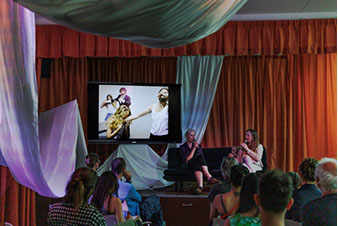MENU

photos: Emma Spannenberg
universal emotions
a recap of the artist talk with Nina Wijnmaalen (June 28, 2024)
by Sonia Polidori
July 8, 2024
At the sixth studium resort,
we had a conversation with Nina Wijnmaalen, an artist and performance director that works with
universal emotions.
Initially working with photography and film, Nina’s practice moved >>> to the theatrical. when creating a stage for her photographs, the artist realized how the process for the photograph was more intriguing and had a higher emotional impact than the final static product,
which for her lacked
“blood,
sweat,
and tears.”
From still to >>>moving>>> images,
Nina started placing people on the stage, adding a
live element into her work.
At the base of this
transformation
was the artist’s desire to connect with the audience’s emotions:
in photography and film, she believes this direct connection is
lost,
and she wished instead to have → “live people in front of live people.”
Her work originates from images or memories
she has in her mind and then seeks for people that
fit them.
For her performers, Nina focuses on how people
look
and
behave,
<<<< extracting certain characteristics out of people and inserting them in a performance. She works with who the performer is, how they
express emotions, and what she sees in them,
“I don’t want to erase [them] completely,”
she mentions.
A recurring theme in the artist’s work is the
tension
between
a dominant father and a submissive mother
she grew up with, which she explores in her performances.
However, her early works started out as more
abstract,
making it challenging to identify the maternal and paternal figures. For this reason, she
>>> transitioned >>>
to a more narrative style, aiming to balance the therapeutic aspect of the work with greater public accessibility. Nina’s aim is to represent
universal images and emotions
by telling short stories that an audience should be able to follow.
Nina considers herself a
‘slow worker.’
Her pieces often begin with drawings of memories, a process that might even take years. She then seeks for the people and the space. this deliberate pace allows her to
digest
and reflect
on her previous work,
identifying elements or individuals to incorporate into the next >>> piece.
Nina frequently works multiple times with the same performers
–blending them with new ones–
as she finds safety in working with familiar faces. Her slow process also allows her to build a much stronger bond with the performers, whom she considers a
family.
Her daughter was also part of her latest performance on the 29th of June, 2024. → this illustrates how Nina does not necessarily seek for artists as performers, but rather works with people she finds
interesting and
fitting for her vision.
In her work, Nina presents <<recurring motifs>>, such as eating apples, which she considers to have a
quasi-religious quality,
despite not being religious herself.
This symbolism reflects her background as a visual artist more than as a director. Although she sometimes fears that her approach might be too visual, her performances remain theatrical through careful styling and costuming of the performers.
Within the
| binary |
of
theater and performance art
she situates herself always
in between.
An audience member asked if she would ever choose one over the other, which she found difficult to answer. she appreciates elements of
both practices
but she feels that her art audience understands her better.
In theater, there is the expectation of a narrative, whereas Nina creates images
like a painter, leaving interpretation up to the audience.
theater has more assigned roles while performances add the element of
the unexpected.
Rather than controlling and assigning roles, she collaborates extensively with the performers,
who contribute to shaping the
final performance.
Lastly, we leave the space having had a glimpse into Nina Wijnmaalen’s practice, who effectively
blurs
the boundaries
between
theater and performance art,
aiming to evoke universal emotions that originate from personal and intimate experiences.
By exploring the space between these two practices, Nina challenges traditional boundaries and creates narratives that the audience can resonate with. Her unique approach, rooted in her personal memories, allows her to connect intimately with
her audience but also with her performers.
––––––
about
Sonia Polidori (2001, Italy) is currently studying Curatorial Studies (University of Groningen, master Art History)
“Nina Wijnmaalen (Groningen, 1980) directs performances that are somewhere between theatre, dance and performance, using movement, poetry and music. There is beauty in her work, but the darker side of human beings is also never far away: judging others, not being able to communicate and struggling to hold on to love. All elements that she knows all too well from her personal life, and makes part of her work with ruthless honesty.”
(By: Luuk Heezen, Kunst is Lang, 2020)
Wijnmaalen has developed her working method by participating in workshops by international performers and institutions including Ivo Dimchev (Tanz im August, Berlin 2010) and Trajal Harrell (Impulstanz, Vienna 2013), PAS (Performance Art Studies, Rotterdam 2012) and SNDO (School for New Dance Development, 2013). Wijnmaalen previously screened work at DansBrabant (2021), the Wijk de Wereld Stadsschouwburg Groningen (2020) and Silbersee SPR!TZL Muziekgebouw in Amsterdam (2019), the Dansmakers in Amsterdam (2014) and Drieons Jong Talent in Tilburg (2015) , Galeria Vermelho Brazil, Stalker Teatro Turin Italy (2015) and Stantsia Dialogue Dance Kostroma Russia (2014) and during several editions of Noorderon Performing Arts Festival (2011/2012/2019).
! This talk was in celebration of the premiere of Nina's new work 'LIEFHEBBEN' on the 29th of June. Accompanied by new work of Mylan Hoezen (S01E02) and Michiel Teeuw (Midseason’22). More info: performances.weticket.io/a-room-full-of-beating-objects





